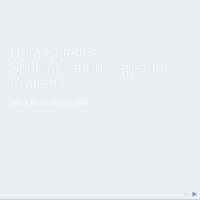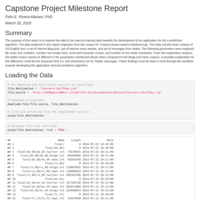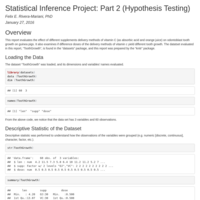Recently Published

Data Analysis in a General Education Biology Course after the First Summative Assessment
This report converge a data analysis of the General Education course taught during the term summer term (2016-3) of the academic year 2016-2017. This course is administered to non-science majors, most of whom are freshman and sophomore students, in a web-enhanced format through Blackboard Learn at Miami Dade College. In this data analysis report, which was performed just after exam 1 was administered (out three to be administered in the course), addressed the following questions:
1) How does exam 1 scores compare to scores in formative assessments (quizzes, polling questions, and reading assignments)?
2) How many students had a higher score in exam 1 compared to their mean Quizzes scores?
3) Which question, topic, Bloom's taxonomy level, knowledge dimension, and format had the lowest proportion of correct answers?
4) Is there a relationship between formative (quizzes, reading assignment, reef polling question) and exam 1?
5) If there was relationship, which formative assessment had more predictive power of the exam 1 grades?
6) Is there a relationship between attendance and exam 1?
7) Is there a relationship between attendance and quizzes?
8) How does the proportion of corrects differ between assessments?

Aseptic Transfer: Time-to-Completion
This report evaluates differences in time-of-completion of aseptic technique transfer in two different Microbiology Laboratory (MCB2010L) sessions (1419, 1441) taught during the Fall semester of the academic year 2016-2017 at Miami Dade College. The students, with the aid of a classmate, recorded themselves performing a slant-to-broth aseptic transfer. The recorded video of the aseptic transfer technique was then uploaded through a Dropbox link sent via email by the professor.

An Exploratory Statistical Overview of Puerto Rico Winning Streak in the 2017 World Baseball Classic
In this report, I present a brief overview, from an exploratory statistical standpoint of the offense and pitching performances, of the Puerto Rico winning streak during the 2017 World Baseball Classic (WBC2017) before the final game vs Team USA. As of the day this report was prepared, Puerto Rico have 7 wins and are heading to the WBC 2017 final. Let’s evaluate how Puerto Rico’s execution in offense and pitching supports Team Puerto Rico undefeated record.

Data Analysis on a Survey Administered to Students on the 1st Day of Class in a General Education Biology Course
This data analysis report evaluates the responses of a survey, which was administered to students (through Blackboard Learn) on the first day of the General Education Biology (BSC1005) course at Miami Dade College during the 2016-2 term (Fall 2016-2017 semester). After students completed the survey, which contain 8 questions (refer to Questions in the Survey below), the raw data was downloaded from Blackboard Learn into a local directory. The file with the raw data was saved as Microsoft ExcelTM file. For questions with character (i.e. word) responses, such as question 1, 7 and 8, the most frequent words as well as the total words per student’s responses were determined. For the remaining questions, the proportion of answers was determined.

Microbiology Laboratory (MCB3023L, section 13354) Pipetting Competition
This report describes an accuracy and precision competition within an upper division microbiology laboratory course. The classroom, which is divided into 6 tables (maximum of four students per table), was challegned into an accuracy and precision with pipetting techniques. This challenge was an extension from the accuracy and precision topics that were discuss in the laboratory classroom the same day of the competition. Students also had an online reading assignment, due before the laboratory class session, that covered pipetting techniques, and the professor discussed the technique before the competition as well.

Relationship between Formative Assessments and a Summative Assessment (i.e. Midterm Exam) in a Introductory Microbiology Lab Course
This data analysis report evaluate **relationships between formative assessments (i.e. low-stake quizzes, reading assignments, and in-class polling questions) and a summative assessment (i.e. Midterm Exam) in a Introductory Microbiology Lab Course. In addition, scores in a Pre-Test summative assessment administered the first day of class were compared to those of the Midterm Exam. Similar types of data analysis have been carry out in courses that I have taught at Miami Dade College with the main goals of identifying areas that students may be struggling and/or learning practices that may need to be modified. In addition, comparing scores in earlier formative examinations with recent ones will provide an initial assessment into the students progress in the course.

Data Sciences Specialization Capstone Project
This presentation briefly but concisely pitch a shiny app elaborated to predict next words followings user's words input. This presentation is part of the Data Science Specialization Capstone Project

Lab Report: Effect of Physical Forces on Bacterial Growth
This document provides data for students at the upper division Microbiology Lab Course (MCB3023L, section 911288, semester 2015-2) taught at Miami Dade College by professor Rivera-Mariani (www.friveam.com). The data of this documents relates to the effect of physical forces on bacterial growth. Students enrolled in this course will answer a series of questions related to the data include in this document.

Lab Report: Precision and Accuracy (Pipetting Techniques)
This document provides data for students at the upper division Microbiology Lab Course (MCB3023L, section 911288, semester 2015-2) taught at Miami Dade College by professor Rivera-Mariani (www.friveam.com). The data of this documents relates to a pipetting exercise carryout in the course. Students enrolled in this course will answer a series of questions related to the data include in this document.

Capstone Project Milestone
The purpose of this report is to explore the data to be used as training data towards the development of an application for the a prediction algorithm. The data analyzed in this report originates from the corpus HC Corpora (www.corpora.heliohost.org). This data include three corpora of US English text: a set of internet blog pots, set of internet news articles, and set of messages from twitter. The following parameters were explored: file sizes, line numbers, number non-empty lines, word and character counts, and number of non-white characters. From this exploratory analysis, the twitter corpus seems to different in the parameters mentioned above when compared to the blogs and news corpora. A possible explanation for this difference could be the character limit (i.e 140 characters) set for Twitter messages. These findings must be kept in mind through the workflow towards developing the application and text prediction algorithm.

Helping you select the features of a car
This brief presentation is part of the [Coursera] (http://www.coursera.org) course Developing Data Products, which is part of the Johns Hopkins University 10-courses Data Science Specialization. This peer-assessed project is composed of two parts: 1) developing a Shiny application, and 2) preparing a pitch presentation related to the developed Shiny application. This presentation focuses on the second component of the project.

Relationship between Transmission Type and Motor Vehicle MPG Efficiency
This report evaluates the relationship of transmission type (i.e. automatic or manual) on motor vehicle miles per gallon (MPG) efficiency. The dataset mtcars from the R Package Datasets was evaluated in this report. Exploratory analysis provided evidence to suggest that there is difference in MPG between automatic and manual transmissions. An unpaired t.test was performed, which rejected the null hypothesis (p = 0.001) that the mean MPG between automatic and manual transmissions were equal with a mean MPG difference of 7. After performing a simple linear regression, type of transmissions accounted for 34% in the MPG variability. With multivariate linear regression and An Information Criterion (AIC) stepwise algorithm, it was found that 84% of the MPG variability is explained when transmission type is confounded with, cylinders, horse power, and weight of the car: manual transmission yield a 1.8 MPG increase compared to automatic transmission. From this data analysis, we conclude that transmission type does influence MPG, but this effect is further influence by other motor vehicle variables such as the number of cylinders, horse power, and weight.

Relationship between an exponential distribution and the Central Limit Theorem
This report describes a brief experiment to evaluate the relationship between a exponential distribution and the Central Limit Theorem. In this brief experiment, the data was generated by working with 1000 averages of exponential distributions (n = 40) and lambda = 0.2.

Effect of different supplements' delivery methods of vitamin C (as absorbic acid and orange juice) on odontoblast tooth growth on guinea pigs
This report evaluates the effect of different supplements delivery methods of vitamin C (as absorbic acid and orange juice) on odontoblast tooth growth on guinea pigs. It also examines if difference doses of the delivery methods of vitamin c yield different tooth growth. The datatset evaluated in this report, “ToothGrowth”, is found in the “datasets” package.

Effect of Weather Events on the Economics and Population Health in the US (1950 to 2011)
This report aims to perform an exploratory data analysis of the NOAA (National Oceanic and Atmospheric Administration) Storm Database to evaluate the population health and economic consequences of specific weather events. The data analyzed in this report contains information about major storms and weather events in the United States. In addition, this database provides information of the dates, locations, and fatalities, injuries, and property damage estimates. The years covered in the data analyzed in this report are from 1950 to 2011. From this data, it was found that tornadoes are the most harmful to population health (as measured by estimates of fatalities and injuries), where as tornadoes, thunderstorms, and floods seems to be the leading cause of economic consequences in the US.